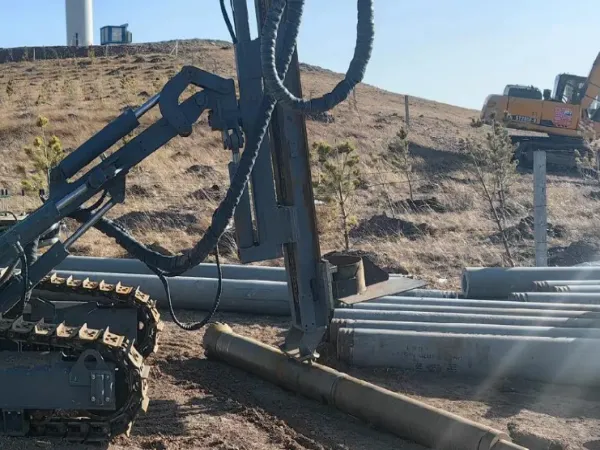Steel pipe piles form a solid foundation for structures such as buildings, bridges and roads. It is typically made of carbon steel and can be manufactured in welded forms, such as SSAW steel pipe or LSAW steel pipe. Therefore, a pipe pile serves as a structural construction material.Pipe piles can be driven or drilled deep into the ground and transfer the load of a building to the stronger soil or rock below. Each different technique can be used depending on the situation and the load the pipe needs to support. This article will introduce in detail the installation method of steel pipe piles.
Driving pile foundations is an important process in engineering construction. However, due to the wide variety of pile foundations, such as steel sheet piles and steel pipe piles, the construction techniques of various pile foundations are greatly different, and the construction stratum structure is complex, so pile foundation construction is very prone to quality problems. Therefore, during the pile foundation construction process, relevant requirements should be strictly followed. At the same time, if problems are found, appropriate measures should be taken in time to deal with them.
Common Installation Methods of Steel Pipe Piles
The two main installation methods used to install pipe piles include driving pipe piles or drilling pipe piles deep into the ground. Each of these primary methods can be accomplished using a number of different techniques, depending on the type of pipe pile used and the environment in which the pipe pile is installed.
- Driven Pipe Piles
Driving pipe piles Special equipment can be used to drive steel piles into the ground. Driving pipe piles into the ground has advantages over drill pipe because the soil displaced when driving a pipe pile into the ground compresses the surrounding soil, creating greater friction against the sides of the pile. This friction can increase the load-bearing capacity of the pipe pile. Driven piles may include open-end piles, which allow soil or sand to enter, or pipe piles with one end of the pipe closed to prevent sand or dirt from entering the center of the pile. Steel pipe piles with one end closed can be filled with concrete to increase stability and retention.
- Drilled Pipe Pile
Drilled pipe piles are also known as caissons,drilled shafts, bored piers, cast-in-drilled-hole piles (CIDH) piles or cast-in-place piles. When using this piling installation method, rotary drilling equipment is used to drive the piles into the ground. Rotary boring or drilling is commonly used for the installation of large diameter piles and for pile construction through particularly dense or hard formations. This method of installing pipe piles can be used in dry ground conditions and when wet drilling in waterlogged formations.

When Is Steel Pipe Foundation Piling Necessary?
Steel pipe foundation piling is necessary in one of two situations. First, if there is a weak layer of soil at the surface of a construction site, the soil will not be able to support the weight of a new structure and therefore a steel pipe foundation piling must be used. Second, if a very heavy building is being built (such as a high rise, bridge or water tank), the surface soil will be unable to support its weight regardless of the soil’s strength and foundation piling must be used. In both situations, the purpose of the steel pipe piling is to transfer the weight of the structure from the soil’s surface to the stronger soil or rock below.
End Bearing Piles vs. Friction Piles
There are two main types of steel pipe foundation piling: end bearing piles and friction piles. With end bearing piles, the bottom end of the pile rests on an underground layer of strong soil or rock. The end of the pile “sits” on this strong layer and presses against it to keep from shifting. When end bearing steel pipe piles are used, the load of the aboveground building is transferred through the pile onto the strong underground layer. In a way, end bearing piles act like building columns.
Friction piles, on the other hand, work more like a wedge in the soil. The friction of the soil around the steel pipe pile is what holds the pile in place, and this is what transfers the weight of the aboveground load to the soil.
Steel Pipe Foundation Piling Installation
Foundation piling pipe can be installed in one of two ways: by cast in place piles or precast driven piles. Cast in place piles are made by hammering a hollow, thin-walled steel tube into the ground. The earth inside the pipe is then removed, and a steel reinforcement cage is lowered into the tube. Finally, wet concrete is poured into the steel pipe to hold it in place.
With precast driven piles, the pipe is first cast at ground level and then hammered into the ground using a pile driver. The pile driver holds the steel pipe piling vertically and hammers it into the ground by striking it with a heavy weight. The steel pipe is given a temporary cap to avoid damaging the pipe while it’s being hammered. The pipe is hammered until “refusal,” when the pipe will physically go no farther.
Conclusion
Steel pipe pile installation is an essential process in foundation construction. Whether using the driving method or the drilling method, steel pipe piles provide stability and load-bearing support for a wide range of structures. By understanding the advantages, considerations, and proper installation techniques, engineers and construction professionals can ensure the longevity and safety of their projects. Proper selection of the installation method and equipment, as well as careful attention to the site conditions, will ensure a successful foundation that meets the demands of the structure and environment.






 English
English Español
Español بالعربية
بالعربية











 Phone :
Phone :  Whatsapp :
Whatsapp :  Email :
Email : 


